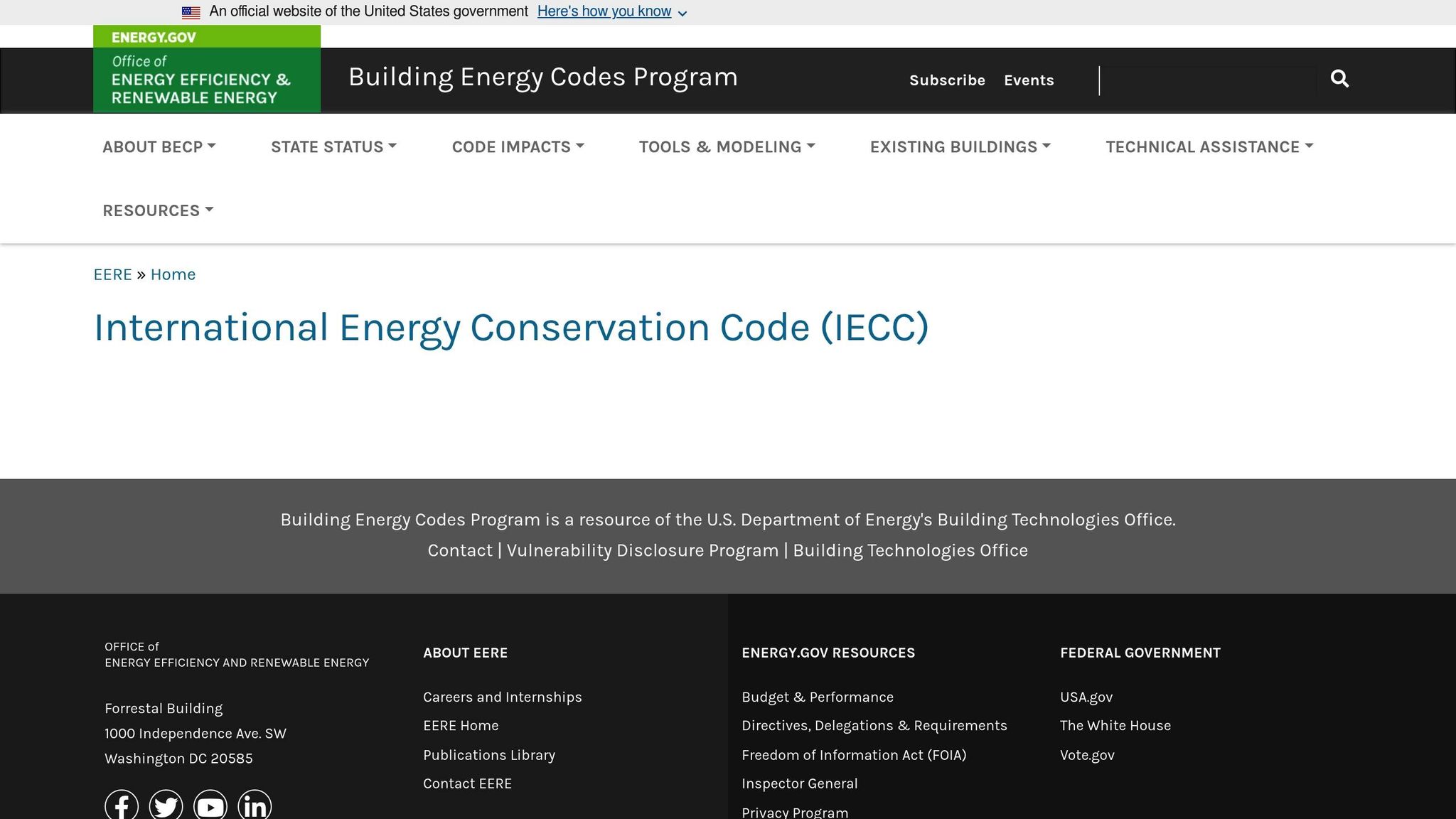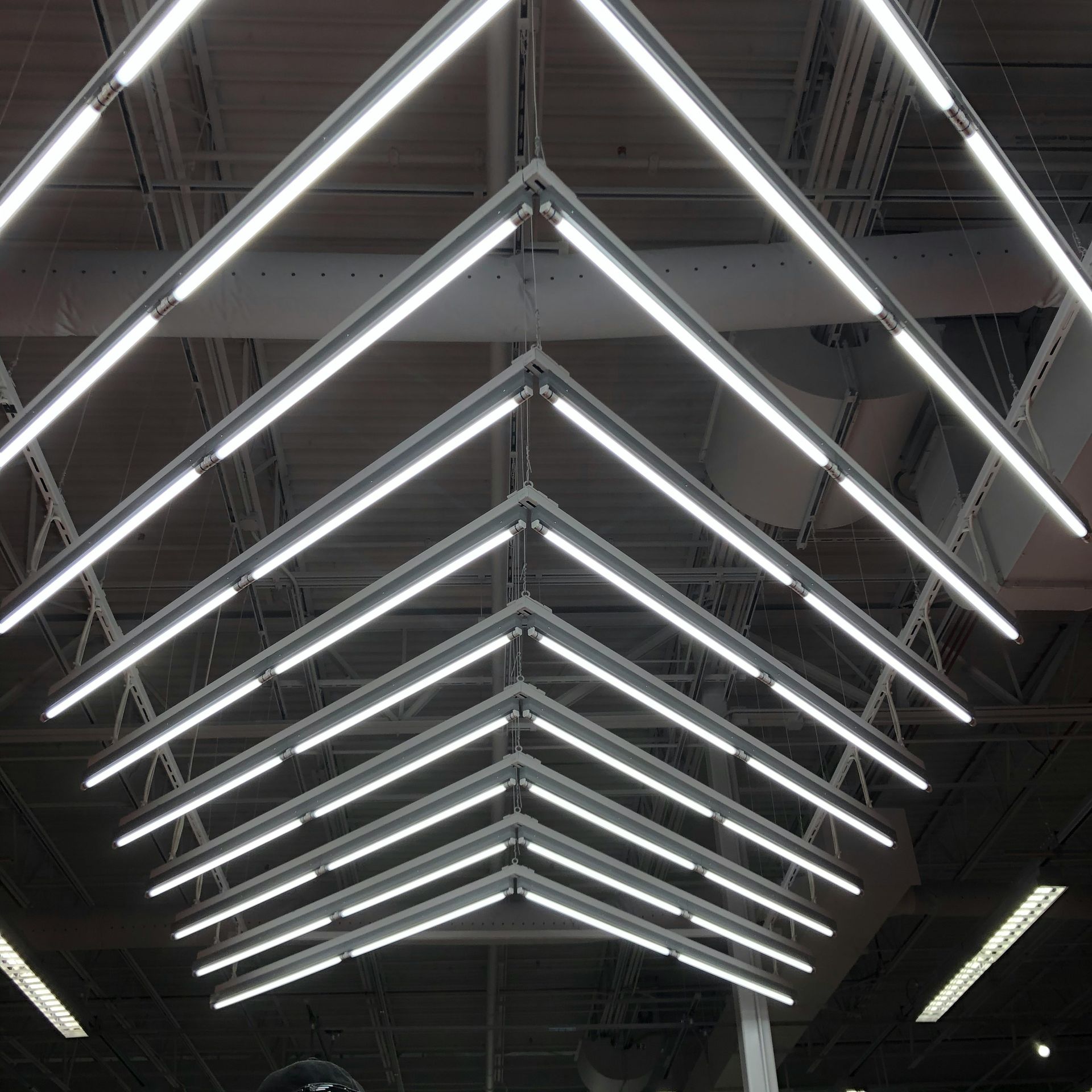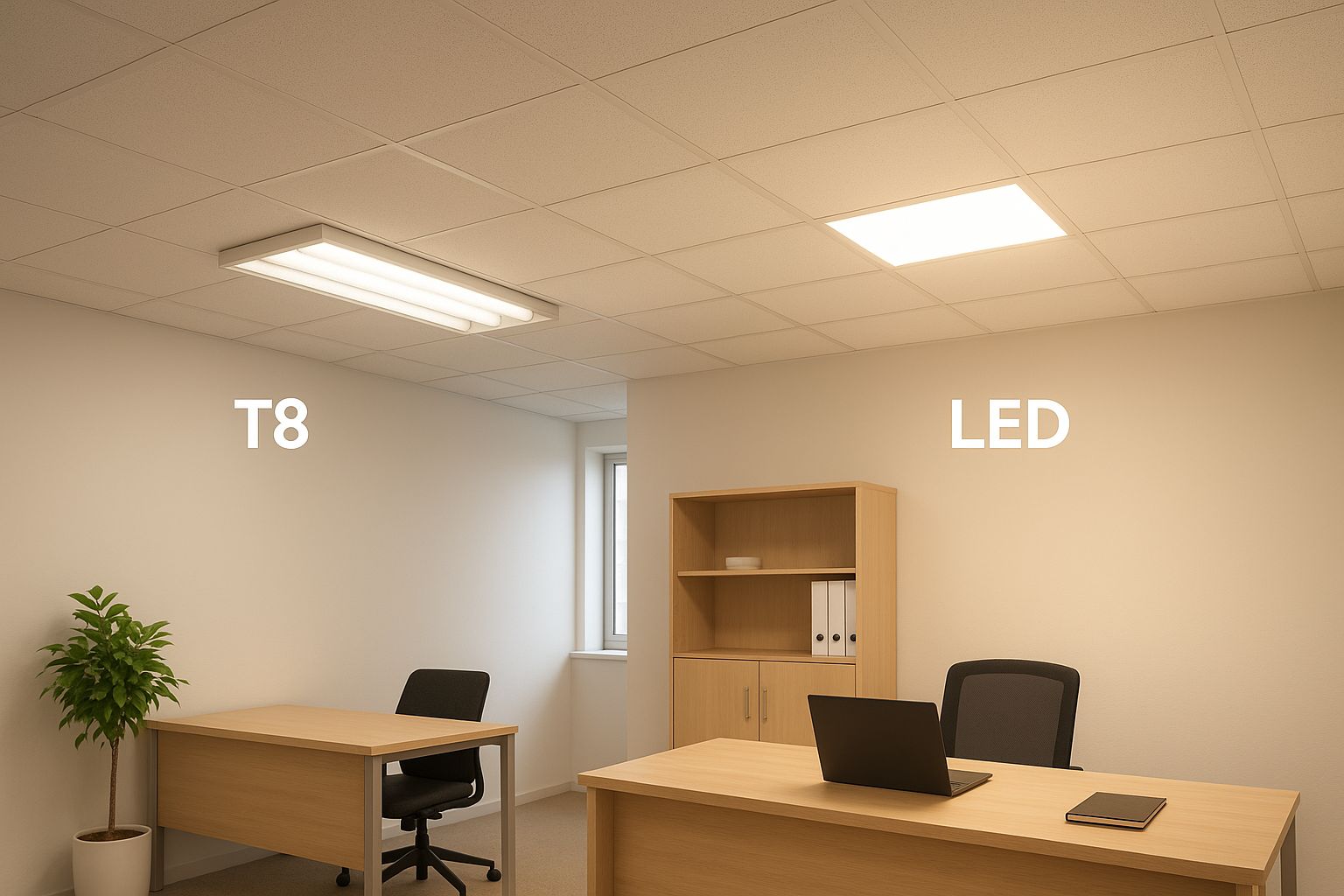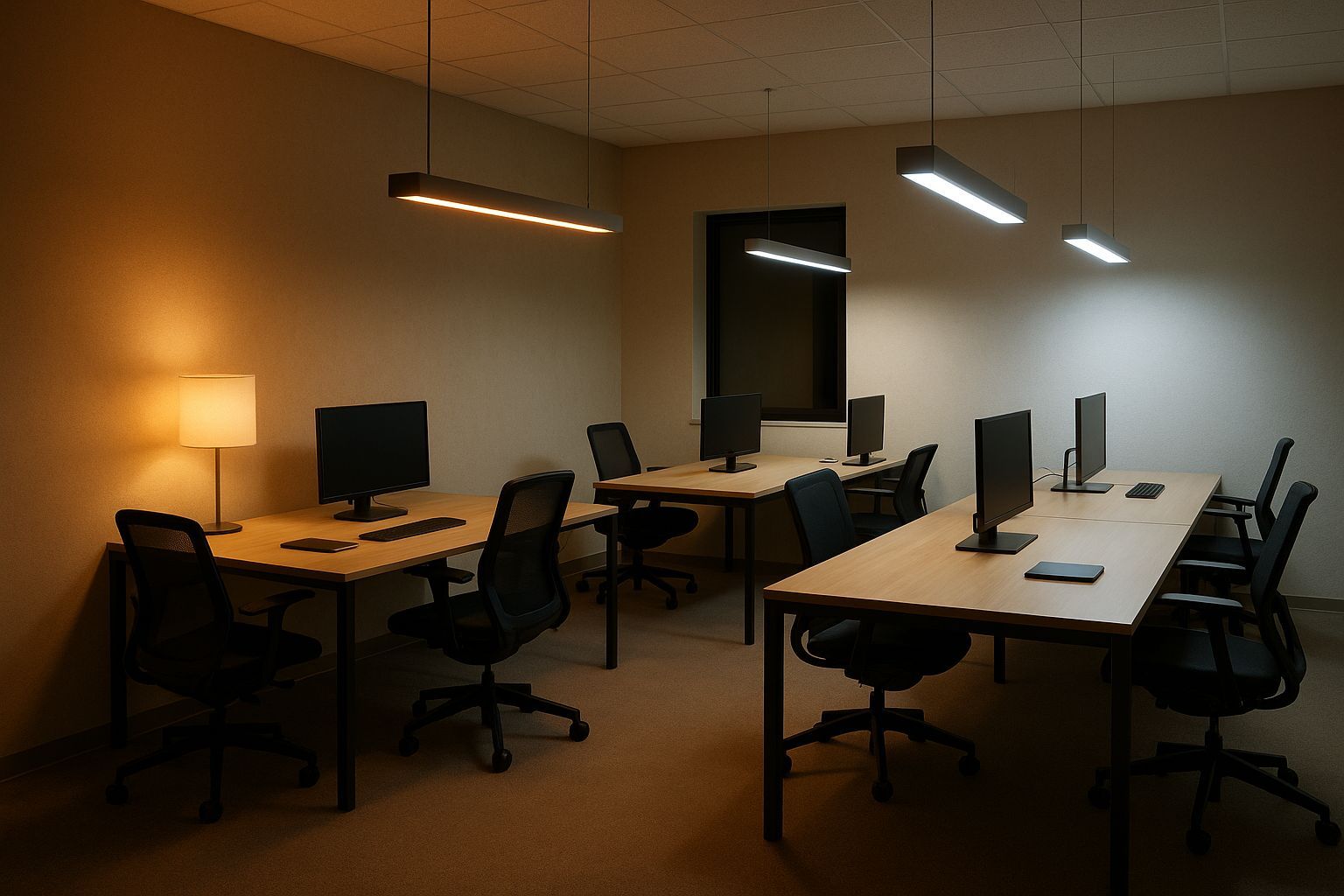2024 Energy Code Updates Impacting LED Lighting
2024 Energy Code Updates Impacting LED Lighting
The 2024 energy code updates are reshaping how commercial and industrial facilities approach LED lighting. These changes, driven by the IECC and ASHRAE 90.1 standards, focus on reducing energy use, improving lighting controls, and enforcing stricter rules for retrofits. Here's what you need to know:
- Lower Lighting Power Allowances (LPA): Buildings must use less energy per square foot for lighting.
- Expanded Lighting Control Requirements: Systems now need advanced controls like occupancy sensors, daylight-responsive systems, and continuous dimming.
- Stricter Retrofit Standards: Even small upgrades must comply with new efficiency rules, making simple replacements insufficient.
LED technology plays a key role in meeting these updates, offering higher efficiency and compatibility with smart controls. Facilities should plan early to integrate these requirements into new construction or retrofits, ensuring compliance while reducing energy costs.
Key Tip: Start with an energy audit and consult professionals to navigate local code requirements, optimize LED systems, and explore rebate opportunities.
What's Up with the 2024 IECC ?

Major 2024 Energy Code Changes for LED Lighting
The 2024 IECC introduces three key updates that raise the bar for LED lighting in commercial and industrial settings.
Lower Lighting Power Allowances
Under the 2024 IECC, lighting power allowances (LPAs) are reduced across the board. Interior lighting sees significant cuts, while exterior lighting allowances are also tightened to limit power consumption.
This trend isn’t new - it reflects a steady tightening of standards over the past two decades. Craig DiLouie, principal of Zing Communications , explains:
Across the past two decades, commercial building energy codes became increasingly stringent for lighting, steadily reducing lighting power allowances while adding detailed control requirements. The 2024 IECC is the latest example of this trend.
For interior lighting, the updated code offers two compliance paths:
- The Building Area Method calculates power allowances for the entire building based on its type.
- The Space-by-Space Method assigns specific allowances for individual spaces, with additional allowances available for certain uses.
For exterior lighting, base site allowances are determined by lighting zones, with extra allowances for specific applications.
| Building Type | 90.1-2016 | 90.1-2019 | 90.1-2022 |
|---|---|---|---|
| Office | 0.79 W/sq.ft. | 0.64 W/sq.ft. | 0.62 W/sq.ft. |
| Retail | 1.06 W/sq.ft. | 0.84 W/sq.ft. | 0.78 W/sq.ft. |
| School/University | 0.81 W/sq.ft. | 0.72 W/sq.ft. | 0.70 W/sq.ft. |
| Hospital | 1.05 W/sq.ft. | 0.96 W/sq.ft. | 0.92 W/sq.ft. |
| Manufacturing | 0.90 W/sq.ft. | 0.82 W/sq.ft. | 0.82 W/sq.ft. |
| Warehouse | 0.48 W/sq.ft. | 0.45 W/sq.ft. | 0.45 W/sq.ft. |
These reductions demand precise planning when selecting LED fixtures and layouts. While LEDs are already highly efficient, further cuts in power allowances make it challenging to maintain proper lighting levels without impacting visual comfort.
These stricter power limits also bring about more rigorous control requirements, which are outlined below.
New Lighting Control Requirements
The 2024 IECC introduces several updates to lighting control standards, directly affecting how LED systems are designed and managed. For starters, bilevel switching has been replaced with continuous dimming controls for general lighting in many spaces.
Occupant sensors are now mandatory in specific areas like data centers, telemedicine rooms, and laundry facilities. Additionally, corridor lighting must include sensors that reduce lighting power to at least 50% within 20 minutes of vacancy, provided the darkest point on the floor maintains at least two footcandles.
Another major change involves daylight-responsive controls, which are now required in spaces where lighting power exceeds 75 watts in a single zone or 150 watts across multiple zones. This adjustment broadens the scope of spaces that must employ daylight harvesting systems.
The code also emphasizes demand-responsive lighting controls, which must reduce lighting output to 80% or less when a demand response signal is received. Functional testing is now required for both high-end trim controls and demand-responsive systems. Furthermore, the luminaire-level lighting control (LLLC) compliance path has been removed as a formal option, though LLLC remains a valid compliance method.
These updated control requirements extend to retrofit projects, as detailed in the next section.
Updated Retrofit Project Rules
The 2024 IECC eliminates the exemption for projects replacing less than 10% of luminaires. Additionally, exterior retrofits exceeding 400 watts must now fully comply with both lighting and control requirements.
For warehouses, the updated code mandates that lighting power in aisles must be reduced to at least 50% within 20 minutes of vacancy.
These updates underscore the code's focus on maximizing energy savings, not just in new construction but also in retrofits. Facilities planning lighting upgrades must now evaluate their projects against stricter standards, which may require more extensive system updates. Simple fixture replacements may no longer suffice - projects must include integrated controls like sensors, dimming systems, and automated shutoff features to meet compliance requirements.
How LED Technology Supports Code Compliance
LED technology has come a long way, now meeting the stringent demands of the 2024 energy codes with impressive advancements in efficiency and smart integration. These improvements allow commercial and industrial facilities to stay compliant while maintaining top-notch lighting quality.
Improved LED Efficiency
Modern LED fixtures deliver exceptional lumens-per-watt performance, directly addressing the stricter power allowances outlined in the 2024 IECC.
The energy savings are striking. LEDs consume up to 75% less energy compared to traditional options like fluorescent and incandescent bulbs. For commercial spaces, this efficiency translates into tangible benefits. For instance, buildings designed to meet ASHRAE 90.1-2022 standards are roughly 14% more energy-efficient than those adhering to the 90.1-2019 standards.
Michael Jouaneh, Manager of Sustainability and Energy Standards at Lutron , sheds light on the challenge:
As we look at energy code trends, we can expect a continued focus on lighting control. Since LEDs are already so efficient, it is getting harder to reduce lighting power allowances without negatively affecting the occupant's visual acuity. As a result, more lighting control requirements may be needed instead of lower lighting power.
This insight explains why the 2024 codes lean more heavily on control systems rather than solely targeting further reductions in lighting power. These efficiency gains are essential for meeting the tighter limits.
Smart Lighting Control Integration
Beyond efficiency, integrating smart controls with LED systems takes energy savings and compliance to the next level. The 2024 energy codes emphasize advanced control strategies, perfectly aligning with the capabilities of modern LED systems. Networked lighting controls (NLCs) combine multiple LED fixtures with smart strategies to enhance both energy efficiency and occupant comfort. On average, these systems deliver 47% savings in lighting energy.
Specific code requirements are also addressed through smart systems. For example, daylight harvesting - using continuous dimming equipment managed by photo sensors - can reduce lighting energy use by 30% to 40%. Controlled LED systems can slash energy consumption by 25% to 75% compared to uncontrolled setups. When paired with HVAC systems, overall energy savings can climb to 30%.
Real-world examples highlight the impact of these technologies. In 2023, Memphis upgraded 77,000 streetlights to LED with networked controls, cutting energy use by over 37 million kWh and reducing energy costs by 55%. Similarly, the Salt Lake City School District implemented LED lighting and wireless controls in 37 buildings, expecting to save $600,000 annually and lower energy consumption by 6 million kWh.
Brendon Van Campen, Senior Sales Director at Lutron Electronics, underscores the transformative potential of smart controls:
Cloud-connected technologies and smart dashboards are revolutionizing lighting control systems. Software updates can be pushed via the cloud as technology improves, ensuring that the lighting control systems become more valuable and powerful over time. Smart wireless control systems can be used in both new construction and retrofit projects, reducing installation costs while enhancing data capture to deliver buildings that can quickly adapt to changing needs and even changing occupants.
These advanced controls are essential for meeting and proving compliance with the updated codes.
For facilities planning upgrades, companies like Luminate Lighting Group offer expertise in integrating advanced LED systems with smart controls. Their focus on custom lighting design and energy audits helps facilities navigate the complexities of the 2024 energy codes while maximizing energy efficiency.
Impact on Commercial and Industrial Facilities
The 2024 energy code updates push commercial and industrial facilities to rethink their lighting strategies. These changes aim to improve energy efficiency by about 10%, which translates to lower long-term costs through reduced energy use and maintenance. By adopting modern LED technology and smart controls, facilities can meet these stricter standards while improving overall energy performance.
Planning now requires integrating renewable energy mandates for specific building types and adjusting to reduced lighting power allowances without compromising lighting quality. Additionally, the removal of the luminaire-level lighting controls (LLLC) compliance path narrows the range of available solutions. Four regulatory terms now dominate the conversation: Lighting Power Allowance, Open Office Occupancy Controls, Automatic Daylighting Controls, and Automatic Receptacle Control. Early, detailed planning is more critical than ever.
Code Compliance Steps
Strict compliance measures for projects now heavily influence costs, timelines, and integration. New documentation requirements mandate commissioning to verify that all systems function as intended. This includes detailed records of control programming, sensor calibration, and performance verification throughout the project. Functional testing is also a cornerstone of compliance. Facilities must:
- Ensure all automatic controls - like receptacle, occupancy, time-switch, and dimming systems - work as intended, with thorough documentation of programming and calibration.
- Confirm that continuous dimming controls are functional in general lighting areas, as bilevel switching is no longer an acceptable option.
- Test exterior lighting systems to ensure they automatically turn off when daylight is sufficient and reduce output by at least 50% during nighttime hours.
These rigorous testing standards provide a framework for evaluating retrofit projects against new construction efforts.
Retrofit vs New Construction Considerations
When deciding between retrofits and new construction, facilities must weigh immediate savings against long-term efficiency. The 2024 IECC requires full compliance, even for small interior retrofits.
Retrofit Projects:
Retrofits can deliver quick energy savings and a faster return on investment (ROI). However, they often face challenges when integrating with existing systems.
New Construction Projects:
New construction offers the opportunity to design systems from the ground up, incorporating advanced LED technology and controls for optimal efficiency. While upfront costs and planning complexity are higher, these projects simplify compliance with the latest standards.
| Project Type | Key Advantages | Primary Challenges | Compliance Focus |
|---|---|---|---|
| Retrofit | Quick ROI, immediate savings | Integration with existing infrastructure | Upgrading controls and reducing power |
| New Construction | Custom design, long-term efficiency | Higher upfront costs, complex planning | Comprehensive compliance and renewable integration |
Cost differences between the two approaches are significant. Retrofits are generally less expensive upfront and can be implemented in stages. New construction, on the other hand, demands a larger initial investment but results in systems designed to meet modern standards from the start. Timelines also vary: retrofits are often quicker to complete, leveraging LEDs with lifespans exceeding 50,000 hours to reduce future disruptions. New construction may take longer to plan but ensures a fully integrated, compliant system.
Facilities navigating these complex updates can benefit from working with experienced providers like Luminate Lighting Group. Their expertise in energy audits, custom lighting designs, and LED retrofits helps facilities choose the most cost-effective path while meeting all compliance requirements. Starting early and focusing on comprehensive control solutions can help manage both costs and project timelines effectively.
sbb-itb-86fe545
Best Practices for 2024 Energy Code Updates
Getting a head start on energy code requirements is key to staying compliant and improving efficiency. By following these strategies, facility managers, lighting specifiers, and contractors can meet the updated standards while optimizing energy use.
Include Code Requirements Early in Design
The foundation of energy code compliance lies in addressing requirements right from the start of any lighting project. With the 2024 IECC introducing stricter regulations, leaving these considerations for later can lead to costly and impractical last-minute changes. Early planning not only avoids these pitfalls but also ensures that lighting systems work seamlessly together.
Start with a detailed evaluation of your current lighting setup and energy usage. Use a checklist to track building plans, energy calculations, and control specifications - this helps keep the project aligned with code requirements.
A major update in the 2024 IECC is the mandate for continuous dimming controls. This means design teams need to plan for advanced control systems right from the beginning. Developing a clear compliance strategy early on ensures all necessary upgrades are identified before construction, saving both time and money.
Once early planning is in place, the focus shifts to selecting energy-efficient solutions like LED retrofits and smart lighting systems.
Use LED Retrofits and Smart Lighting Solutions
Modern LED technology paired with smart controls offers a straightforward way to meet the updated 2024 codes. LED retrofits can reduce energy use by as much as 85%. When combined with networked controls, these systems can deliver an additional 50% in energy savings.
The 2024 IECC emphasizes reducing energy consumption through automatic lighting adjustments based on occupancy, time, or ambient light levels. Advanced LED systems excel here, providing high color accuracy (often with CRI ratings above 90), consistent illumination, and eliminating issues like flickering. They’re also mercury-free and have a much smaller carbon footprint compared to older lighting technologies.
Smart technology takes energy efficiency a step further by enabling automation through features like occupancy sensors, daylight harvesting, and scheduling. Networked lighting systems allow for personalized settings, such as adjustable light levels and color temperatures, enhancing comfort and productivity for occupants. These features not only help meet the code's focus on automatic controls but also improve the overall experience for users.
Beyond energy savings, there are financial perks. Many utility companies and government programs offer rebates for sustainable upgrades. Additionally, LEDs have a lifespan that far surpasses traditional incandescent and fluorescent bulbs, cutting down on maintenance costs and disruptions.
To make the most of these technologies, it’s best to work with professionals who understand the nuances of the new standards.
Work with Experts for Code Compliance and Energy Savings
Navigating the complexities of the 2024 energy codes is no small task, which is why professional guidance is so valuable. Experts not only ensure compliance but also help maximize efficiency.
Lighting professionals provide a range of services to address every aspect of compliance. Detailed audits assess current light levels, energy use, and adherence to local codes. These evaluations help pinpoint areas for improvement and prioritize upgrades that will have the greatest impact.
Professionals also bring a deep understanding of jurisdiction-specific requirements. This is especially important given the 2024 IECC’s new standards for functional testing of lighting controls, automatic receptacle controls, and documentation.
Take Luminate Lighting Group, for example. They offer a comprehensive approach to compliance, handling everything from energy audits to custom lighting designs and LED retrofits. Their expertise includes creating photometric layouts, specifying fixtures and controls, and ensuring eligibility for rebates - essential steps for successful compliance.
Partnering with experienced professionals ensures a smooth transition to updated lighting systems. They can also set up proactive maintenance plans to keep systems running efficiently and in compliance over time. Considering that lighting can account for up to 25% of a building’s energy use, expert guidance is crucial for meeting the energy-saving goals outlined in the 2024 codes.
Preparing for Success Under 2024 Energy Codes
The 2024 energy codes bring stricter requirements for lighting efficiency, but with the right approach, these changes can become opportunities for operational improvements and cost savings.
Understanding the new regulations is the first step to staying ahead. It’s essential to confirm when your local jurisdiction will adopt the 2024 IECC to avoid costly surprises. One key requirement is the use of automatic lighting controls that adjust based on occupancy, time, or ambient light levels. This clarity in regulations sets the stage for incorporating LED solutions that are both compliant and high-performing.
"Energy codes ensure that a building's energy use is included as a fundamental part of the design and construction process; making this early investment in energy efficiency will pay dividends to owners and occupants."
– Building Energy Codes Program
Combining LED technology with smart controls offers a straightforward way to meet these requirements while unlocking additional benefits. Modern LED fixtures, when paired with advanced controls, can drastically reduce energy consumption. For example, networked lighting controls can deliver up to 47% more energy savings by providing precise control and detailed energy usage insights. These savings not only lower energy bills but also enhance overall operational efficiency.
The financial benefits of compliance are hard to ignore. Buildings account for roughly 40% of total energy use, with energy codes directly impacting up to 80% of a building's energy load. Deep retrofits can lead to dramatic reductions in energy use - between 58% and 79% - compared to smaller-scale measures like weatherization, which typically achieve only 10% to 20% savings.
The 2024 IECC also emphasizes thorough testing and documentation for lighting and automatic receptacle controls. This makes it crucial to seek professional expertise to navigate specific local requirements and take full advantage of available rebates and incentives.
Acting now can save time and money. By 2035, it’s estimated that 75% of U.S. buildings will be either new or renovated. Facilities that address these updated energy codes during the design phase can avoid the higher costs of retrofitting later. Additionally, as utility companies increasingly focus on advanced energy management technologies in their rebate programs, early adopters have the chance to secure immediate financial incentives and long-term savings. Aligning your design and operations with the 2024 codes ensures compliance while delivering lasting energy and cost efficiencies.
For expert assistance with LED lighting retrofits, custom lighting designs, and energy audits tailored to meet the new energy code requirements, consider working with Luminate Lighting Group (https://luminatelightinggroup.com). Their expertise can help your facility achieve peak energy efficiency and seamless compliance with the 2024 energy codes.
FAQs
What changes in the 2024 energy code affect LED lighting in commercial and industrial spaces?
2024 Energy Code Updates for LED Lighting
The 2024 energy code brings tighter regulations for LED lighting in commercial and industrial spaces. Key changes include lower lighting power allowances, mandatory advanced lighting controls, and stricter efficiency standards for LED fixtures.
These adjustments are designed to cut energy use, align with modern efficiency benchmarks, and promote more sustainable practices. For businesses, this means upgrading their lighting systems isn't just a good idea - it’s necessary to meet these updated requirements.
How do smart lighting controls paired with LED systems align with the 2024 energy code updates?
Integrating smart lighting controls with LED systems is a practical way to align with the 2024 energy code updates. These advanced controls can automatically adjust lighting based on factors like occupancy, available daylight, or pre-set schedules. The result? Less wasted energy and lower utility bills.
Beyond saving energy, smart lighting controls also improve comfort for occupants. They create flexible lighting environments that adapt to different needs while ensuring compliance with updated regulations. This approach not only supports sustainability efforts but also helps businesses meet regulatory requirements - all while enhancing the overall functionality of their spaces.
What steps can facilities take to comply with the 2024 energy codes for LED lighting during retrofits or new construction?
To meet the 2024 energy codes, facilities should begin with a comprehensive energy assessment to pinpoint areas that require upgrades. Implementing energy-efficient solutions, like LED lighting systems , not only helps achieve compliance but also cuts down on energy usage.
Referencing up-to-date standards, such as the 2024 IECC and ASHRAE Standard 100-2024, is essential to ensure that all lighting and energy systems meet the new regulations. Leveraging energy modeling tools and seeking guidance from experts in energy-efficient lighting design can make the compliance process smoother and deliver better results.




